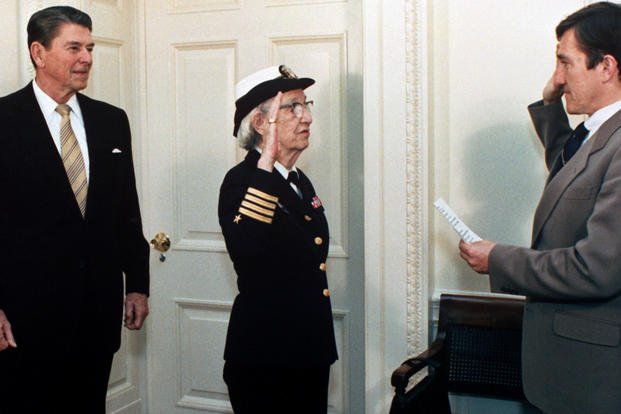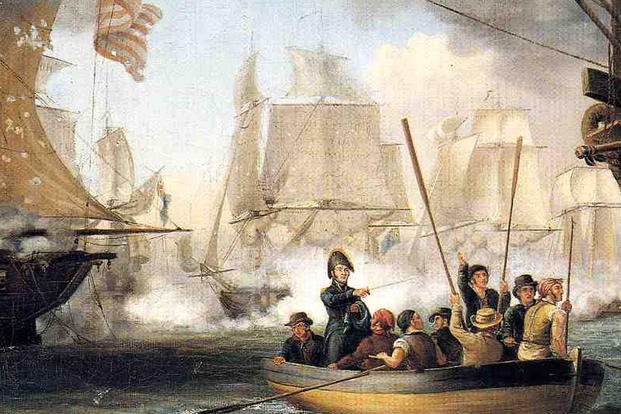When Navy legend and computer programming pioneer Grace Hopper was promoted to O-7 in 1982, she pinned on the one-star insignia and became Commodore Hopper. If she had been promoted just a few years earlier, she would have pinned on two stars and her rank would have been rear admiral lower half.
If she had been promoted a few years later, she still would have been called Rear Admiral Lower Half Hopper, but she'd have only a one-star insignia.
Sounds confusing, right? That's because it is. The Navy has always had a love-hate relationship with the title and rank of "commodore."
Today, senior naval officer ranks proceed as follows: O-6, or captain; O-7, or rear admiral lower half; O-8, or rear admiral upper half; O-9, or vice admiral; and O-10, or admiral. The rank of commodore is absent, although it has made its mark on U.S. Navy history.
Historically, the title was given to a commander who was the captain of a ship, but was in command of a grouped element of ships, often called a squadron. When the Continental Navy was formed in 1775, it adopted the British Royal Navy's customs, traditions, ranks and rating structure. It wasn't until after the revolution that the U.S. Navy began to deviate from those traditions.
At its birth in 1775, the U.S. Navy initially had only four officer ranks, and they did not include "admiral." After reaching a captain's rank, there was nowhere else for an officer to advance. "Commodore" was still reserved for those who were in command of a number of ships.
But even a midshipman could be a commodore under those criteria. To make matters worse, after putting on the title, former commodores were not apt to take it off and become mere captains once more.
By the time the Civil War came around, the Navy had made "commodore" a permanent rank -- finally, a rank above captain -- but the long-term effects were disappointing for the Navy.
The Royal Navy had hundreds of years of privilege and tradition by then. They and other naval powers scoffed and ridiculed having "commodore'' as a rank and did not give these American naval officers their due respect.
It was during the Civil War that Congress stepped in to create the rank of "admiral" as opposed to "flag officer." In 1862, David Farragut was the first rear admiral in the United States Navy. In 1864, President Lincoln named him the first vice admiral. In 1866, he was named the Navy's first full admiral.
By the turn of the 20th century, commodores were out and rear admirals were in.
Except instead of having one-star admirals, the Navy gave all rear admirals two-star rank, with O-7 and O-8 represented by the same rank insignia. This held until World War II, when captains were given higher command than their rank but weren't yet at an admiral's level.
"Commodore" was thus reborn, with one-star insignia. The rank stayed around until 1947, when it once again went away and all naval officers again received two-star insignia when becoming rear admirals. Commodore became an honorific title for senior captains who were in command of multiple units.
By the time Grace Hopper received the O-7 paygrade in 1982, "commodore" had once again made a comeback. The other branches had come to resent the Navy's flag officers for wearing O-8 rank insignia at an O-7 paygrade. So rear admiral (lower half) was replaced first by "commodore admiral" and then simply "commodore."

But the title of "commodore" actually meant something to the Navy's officers. It was more than just a rank and grade, and the rank began to be confused with the title held by officers who commanded multiple units.
Eventually, the Navy scrapped the whole idea and kept the one-star insignia for O-7 officers, while discarding the rank of commodore entirely. In 1983, Grace Hopper became Rear Admiral (Lower Half) Hopper, and commodores were once again captains in command of many units.
Meeting a commodore today would mean meeting a warfare-qualified O-6, a captain, in command of ship squadrons or special operations units and air wings, just to name a few.
-- Blake Stilwell can be reached at blake.stilwell@military.com. He can also be found on Twitter @blakestilwell or on Facebook.
Want to Learn More About Military Life?
Whether you're thinking of joining the military, looking for post-military careers or keeping up with military life and benefits, Military.com has you covered. Subscribe to Military.com to have military news, updates and resources delivered directly to your inbox.















